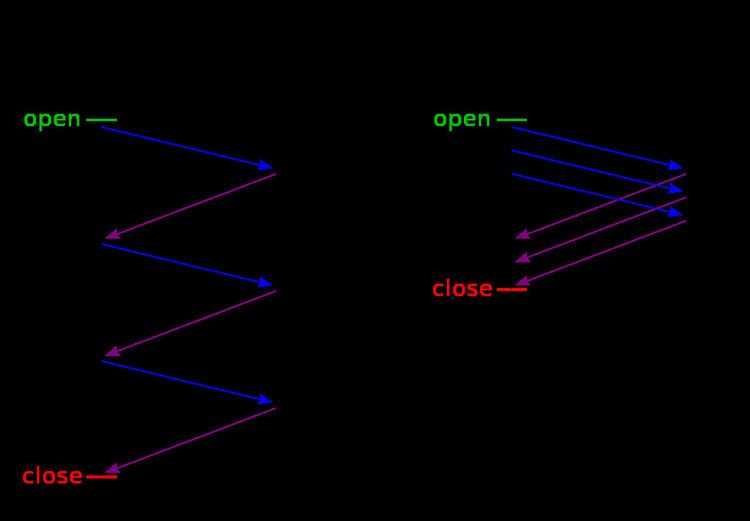 | ||
HTTP pipelining is a technique in which multiple HTTP requests are sent on a single TCP connection without waiting for the corresponding responses.
Contents
- Implementation status
- Implementation in web servers
- Implementation in web browsers
- Implementation in web proxies
- Other implementations
- References
The pipelining of requests results in a dramatic improvement in the loading times of HTML pages, especially over high latency connections such as satellite Internet connections. The speedup is less apparent on broadband connections, as the limitation of HTTP 1.1 still applies: the server must send its responses in the same order that the requests were received — so the entire connection remains first-in-first-out and HOL blocking can occur. The asynchronous operation of the upcoming HTTP/2 or SPDY could be a solution for this.
Non-idempotent requests, like those using POST, should not be pipelined. Sequences of GET and HEAD requests can always be pipelined. A sequence of other idempotent requests like PUT and DELETE can be pipelined or not depending on whether requests in the sequence depend on the effect of others.
HTTP pipelining requires both the client and the server to support it. HTTP/1.1 conforming servers are required to support pipelining. This does not mean that servers are required to pipeline responses, but that they are required not to fail if a client chooses to pipeline requests.
Implementation status
Pipelining was introduced in HTTP/1.1 and was not present in HTTP/1.0.
Implementation in web servers
Implementing pipelining in web servers is a relatively simple matter of making sure that network buffers are not discarded between requests. For that reason, most modern web servers handle pipelining without any problem.
Implementation in web browsers
Of all the major browsers, only Opera based on Presto layout engine had a fully working implementation that was enabled by default. In all other browsers HTTP pipelining is disabled or not implemented.
Implementation in web proxies
Most HTTP proxies do not pipeline outgoing requests.
Some versions of the Squid web proxy will pipeline up to two outgoing requests. This functionality has been disabled by default and needs to be manually enabled for "bandwidth management and access logging reasons." Squid supports multiple requests from clients.
The Polipo proxy pipelines outgoing requests.
Other implementations
The libwww library made by the World Wide Web Consortium (W3C), supports pipelining since version 5.1 released at 18 February 1997.
Other application development libraries that support HTTP pipelining include:
System.Net.HttpWebRequest.QNetworkRequest, introduced in 4.4.Some other applications currently exploiting pipelining are:
Multipart XHR is implementation of pipelining (without any browser or web server support) done purely in JavaScript in combination with server-side scripting.
Testing tools which support HTTP pipelining include:
